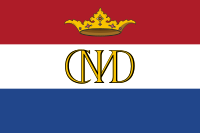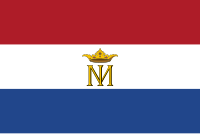
The national flag of Brazil, is a blue disc depicting a starry sky spanned by a curved band inscribed with the national motto "Ordem e Progresso", within a yellow rhombus, on a green field. It was officially adopted on 19 November 1889 — four days after the Proclamation of the Republic, to replace the flag of the Empire of Brazil. The concept was the work of Raimundo Teixeira Mendes, with the collaboration of Miguel Lemos, Manuel Pereira Reis and Décio Villares.

John Maurice of Nassau, called "the Brazilian" for his fruitful period as governor of Dutch Brazil, was Count and Prince of Nassau-Siegen. He served as Herrenmeister of the Order of Saint John from 1652 until his death in 1679.

Lúcio Marçal Ferreira Ribeiro Lima Costa was a Brazilian architect and urban planner, best known for his plan for Brasília.

Caspar Barlaeus was a Dutch polymath and Renaissance humanist, a theologian, poet, and historian.

The Ricardo Brennand Institute is a cultural institution located in the city of Recife, Brazil. It is a not-for-profit private organization, inaugurated in 2002 by the Brazilian collector and businessman Ricardo Brennand. It comprises a museum, an art gallery, a library and a large park.

Henry I of Nassau-Siegen, German: Heinrich I. von Nassau-Siegen was Count of Nassau-Siegen, a part of the County of Nassau, and ancestor of the House of Nassau-Siegen. He comes from the Ottonian branch of the House of Nassau.

Events in the year 1976 in Brazil.

Events of the year 1968 in Brazil

The flag of the state of São Paulo, Brazil, serves as one of the state's symbols, along with the state's coat of arms and anthem. It was designed by the philologist and writer Júlio Ribeiro in 1888, with his brother-in-law, Amador Amaral, a graphic artist. The flag has thirteen black and white stripes and a red rectangle in the upper left corner holding a white circle enclosing an outline map of Brazil in blue. There is a yellow star in each corner of the red rectangle.

The Church and Convent of Saint Antony is a 17th-century Roman Catholic church located in Igarassu, Pernambuco, Brazil. It was constructed by the Franciscans during the settlement of Pernambuco, and was the third Franciscan convent in Brazil. It was destroyed during the Dutch occupation of Brazil and is dedicated to is dedicated to Saint Anthony. The church was rebuilt late in the 16th century and sits adjacent to the Church of Saints Cosme and Damião, the oldest functioning church in Brazil. It was designated a historic structure by National Institute of Historic and Artistic Heritage (IPHAN) in 1938. The church and convent are located in the Historic Center of Igarassu, itself protected as an urban architectural ensemble since 1972.

The Constituent Cortes of 1820, formal title The General and Extraordinary Cortes of the Portuguese Nation, also frequently known as the Sovereign Congress or the Cortes Constituintes Vintistas, was the first modern Portuguese parliament. Created after the Liberal Revolution of 1820 to prepare a constitution for Portugal and its overseas territories, it used a different system from the traditional General Cortes for choosing representatives, and the three traditional feudal estates no longer sat separately. The Cortes sat between January 24, 1821 and November 4, 1822 at the Necessidades Palace in Lisbon. The work of the Constitutional Cortes culminated in the approval of the Portuguese Constitution of 1822.
Agnes of Leiningen was a Countess of Nassau by marriage to Otto I, Count of Nassau. She was probably Regent of the County of Nassau for some time for her youngest son after the death of her spouse in 1289/1290.
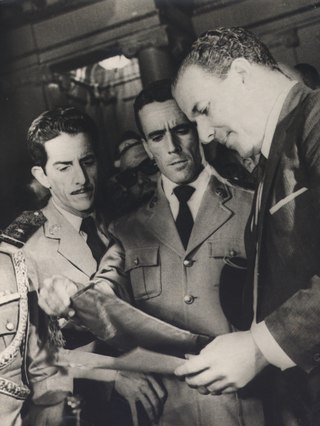
The meeting at the Automóvel Clube was a solemnity of sergeants of the Military Police and Armed Forces of Brazil, on March 30, 1964, in Rio de Janeiro, at which President João Goulart gave a speech. Taking place amid the repercussions of the 1964 Sailors' Revolt, it was one of the immediate factors in the coup d'état that began the following day.

With the 1964 Brazilian coup d'état, on April 2 the National Congress of Brazil declared the presidency of the Republic occupied by João Goulart vacant. Since the vacancy was foreseen for the president's departure from the country without the authorization of Congress, which was not the case, the act had no constitutional support. However, it formalized the coup, transferring the post to the president of the Chamber of Deputies, Ranieri Mazzilli, until the indirect election of General Castelo Branco, the first military president of the dictatorship (1964-1985), days later.

The flag of Pernambuco is one of the official symbols of the Brazilian state of Pernambuco. It is a bicolor pennant, blue and white, with the colors broken horizontally into two unequal sections, with blue in the upper and larger rectangle, the rainbow composed of three colors, red, yellow and green, with a star in above and below the sun, inside the semicircle, both in yellow, and, in the lower and smaller white rectangle, a red cross.
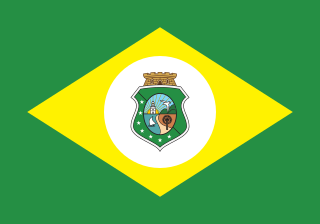
The flag of Ceará is the official flag of the Brazilian state of Ceará. The original version of the flag was adopted on 25 August 1922 by state decree 1,971 of Ceará.
The Brazilian Women Writers Collection is an initiative of the Federal Senate Library, and is published by the Federal Senate Secretariat for Printing and Publishing. Its purpose is to publicise the intellectual work of Brazilian women writers who have been under-represented or practically ignored in the literary canon. By valuing these contributions, the collection seeks to recognise the activities, productions, and ideas of women in the construction of Brazil's history. It also aims to fill a significant gap in publishing by addressing the publication of Brazilian women authors, who are often overlooked in literary studies.
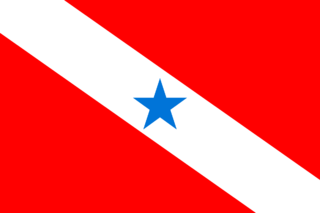
The flag of the state of Pará is, along with the coat of arms and the anthem, one of the symbols of the state of Pará, Brazil as described in article 12 of the state constitution.

